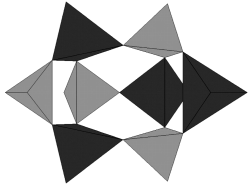Abstract
The synthesis and crystal structures of a new magnesium aluminophosphate
and its high temperature variant are described. The as-synthesized material (UiO-28-as),
of composition MgAl3(PO4)4·C4N3H14·H2O,
crystallizes in the orthorhombic space group Pbcm
(no. 57)
with a = 9.2769(8), b = 14.798(1), c = 14.611(1) Å
and V = 2005.8(3) Å3.
UiO-28-as has a two-dimensional eight-ring channel system, and is isostructural
with a cobalt aluminophosphate (ACP-2) and a cobalt gallophosphate (GCP-2).
Aluminium and magnesium are not uniformly distributed over the three non-equivalent
metal framework sites. One site contains solely aluminium; one is Al-rich
and the third is Mg-rich, leading to an overall Al/Mg ratio of 3. The
magnesium-rich metal atom site is partly coordinated by five


 Please wait while we load your content...
Please wait while we load your content...